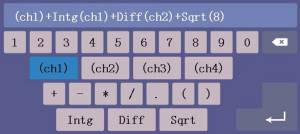Review: OWON XDS3064E 4-channel Oscilloscope with Touch Screen
Features

The first thing I noticed is the sensitivity of the input channels. These can be set down to 1 mV/div (but bandwidth is limited). The noise of the input stages remains quite small with this, otherwise such a high sensitivity would make no sense.
With the Auto-set button you can automatically search for the appropriate settings for a clear display of the input signal. Most scopes have this function, but with this OWON the function is very comprehensive. Here more than 25 settings are automatically performed and with all signals that I tried, it operated flawlessly. In addition there is an Auto-scale button, which changes the horizontal and/or vertical scale automatically, also when the input signal changes. There are, of course, also a large number of manual trigger options.

The Math button does not only allow operations to be performed on the signals, but it is also possible to enter equations. With these even integration, differentiation and square root are available. The XDS3064E also has an FFT function. In this case two windows appear vertically, with the top one displaying the measured signals and the bottom one the FFT analysis. This works well, but reading the FFT signal magnitude is not so easy. You will be counting squares frequently... The countless measurement options do, however, offer a way out. For example, the FFT peak-detection is a very useful feature.
Looking through all the samples in the 40 Mpoints of memory is also very conveniently implemented. Again two windows appear vertically, after which you use the horizontal rotary buttons to scroll through the memory and zoom in.
Conclusion

control the scope from a PC.
For an amount well under 400 euros / pounds with the XDS3064E you will have a robust and versatile 4-channel scope, where perhaps the only shortcoming is the somewhat limited bandwidth of 60 MHz. But if that is enough for you, then this instrument is an excellent purchase that you will certainly not regret.
Read full article
Hide full article


Discussion (0 comments)